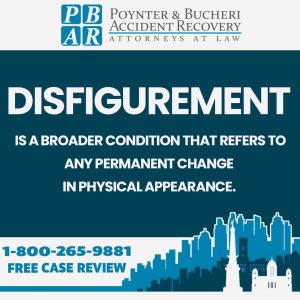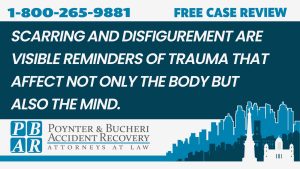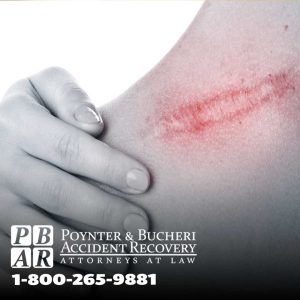Going through a serious accident—like a car crash, spinal cord injury, or broken bone—is hard enough. But when it leaves behind visible scarring or disfigurement, the trauma doesn’t stop once the wounds heal. It is a lasting reminder of what happened and can affect your confidence, mobility, and daily life. That’s why you need an Indianapolis scarring & disfigurement injury attorney.
At Poynter & Bucheri, our experienced Indianapolis personal injury attorneys understand the physical, emotional, and financial toll these injuries can take. We’re here to help you hold the at-fault party accountable, guide you through complex insurance coverage claims, and pursue full and fair compensation. We’re ready to stand by your side every step of the way as you seek compensation. Contact our law firm at 800-265-9881.
What Are Scarring and Disfigurement Injuries?

These injuries occur when the body sustains damage, often from car accidents, burns, or premises issues, that results in lasting changes to a person’s appearance.
Scars form as part of the body’s natural healing process when the dermis (the deep layer of skin) is injured. The body produces collagen fibers to repair the body, which leaves behind a permanent injury mark where the wound once was.
Disfigurement, however, is a broader condition that refers to any permanent change in physical appearance. Disfigurement can include visible scarring, changes in skin texture, burns, or the loss or alteration of body parts. Aside from cosmetic concerns, disfigurement may also lead to catastrophic injuries that reduce mobility, cause nerve damage, or emotional distress.
In both cases, seeking compensation for medical expenses, lost wages, and long-term care is often necessary—and much more manageable with the guidance of an experienced Indianapolis personal injury lawyer.
The Three Types of Scars

Not all scars are the same. Each type forms differently and may require specific treatment:
Hypertrophic Scars
These raised, red scars are caused by excess collagen and remain within the boundary of the original wound. They can be itchy, painful, and sensitive. Treatment may include steroid injections or silicone sheets to reduce their appearance.
Keloid Scars
Keloids grow beyond the original injury site and can be painful or limit movement, especially near joints. Treatment often involves steroid injections, silicone sheets, or surgical removal.
Contracture Scars
Most commonly caused by burns, these scars tighten the skin during healing, limiting mobility and affecting nearby muscles or nerves. Treatment may include plastic surgery or physical therapy.
Understanding the differences between scar types is vital in an Indianapolis personal injury case, as they directly impact your medical needs, long-term effects, and ability to seek fair compensation. An experienced Indianapolis personal injury lawyer can guide you through the process and advocate for the payout you deserve.

Why Scarring and Disfigurement Injuries Aren’t Always Visible
While scarring and disfigurement are often viewed as surface-level injuries, their impact runs much deeper. Victims may experience nerve sensitivity, chronic discomfort, limited mobility, and emotional pain that affect their confidence, mental health, and personal relationships—even when the scars aren’t visible.
In many cases, the emotional toll lasts longer than the physical wounds, leading to anxiety, depression, or isolation. These challenges are why scarring and disfigurement are considered serious injuries in personal injury cases.
Types of Cuts and Lacerations That Can Cause Scarring and Disfigurement
Cuts and lacerations can range in severity. Some may be minor surface wounds, while others are deep and require surgery. Common types include:
- Abrasions – Superficial scrapes typically caused by friction against a rough surface
- Avulsions – Severe injuries where skin or tissue is forcibly torn away, often requiring surgical repair
- Incisions – Straight, clean cuts usually made by sharp objects like knives or glass
- Lacerations – Deep, irregular tears in the skin, often caused by blunt force trauma or sharp objects
- Puncture Wounds – Deep injuries caused by narrow, pointed objects such as nails or metal
If you’ve experienced any of these injuries, a skilled cuts and lacerations injury lawyer from Poynter & Bucheri can help you hold the responsible party accountable and seek the compensation you need for recovery—including medical expenses, lost wages, and pain and suffering.
Medical Complications
The medical implications of cuts and lacerations go beyond the initial injury:

- Reduced Flexibility: Scar tissue lacks the elasticity of healthy skin, which can limit a person’s ability to bend, stretch, or move the affected area comfortably.
- Nerve Damage: Deep wounds may impact surrounding nerves, leading to chronic physical pain or loss of sensation for the injury victim.
- Reconstructive Surgery: Many victims require skin grafts or plastic surgery, especially with facial injuries, which may leave secondary scarring.
- Infections: Improper healing or poor wound care can result in infection, further complicating recovery.
Scarring and disfigurement are visible reminders of trauma that affect not only the body but also the mind. They may even result in wrongful death cases, depending on the circumstances. If you have experienced scarring or disfigurement, contact an Indianapolis personal injury lawyer today to file your personal injury claim.
Treatments You Might Need After a Scarring Injury
Recovering from scarring or disfigurement often requires more than basic wound care. Depending on the severity, future medical expenses may include:
- Stitches or staples
- Skin grafts or reconstructive surgery
- Steroid injections
- Silicone sheets or gels
- Physical therapy
- Mental health support
Treatment plans vary, but long-term care is often crucial for both physical recovery and emotional healing. Working with a personal injury lawyer is an important step in recovering compensation.
Common Causes of Scarring and Disfigurement Injuries
Scarring and disfigurement injuries often result from deep cuts, burns, or trauma—injuries that appear in most personal injury cases and usually require extensive medical treatment. Below are some of the most common causes:
Automobile Accidents

Truck, motorcycle, and car accidents are leading causes of serious injuries, particularly lacerations from shattered glass, torn metal, or airbag deployment. Airbag deployment, broken glass, and twisted metal can lead to deep cuts, facial injuries, and burns.
These wounds often require stitches, skin grafts, or surgery, all of which can leave severe scarring. For a car accident victim, disfigurement—especially to the face—can have a lasting impact on self-esteem and mental health and may even result in a wrongful death case.
Sometimes, car accidents cause disfigurement that affects mobility, nerve function, or self-esteem. The emotional toll can be just as lasting as the physical injuries, with some individuals developing PTSD that makes it difficult to drive again.
Navigating an auto insurance policy, proving fault, and managing legal steps is overwhelming, especially while recovering from a car accident. Working with an experienced Indianapolis personal injury lawyer at Poynter & Bucheri is essential to hold the at-fault party in your car accident accountable and fight for your best recovery.
Burns (First to Fourth Degree)
Burns—especially third- and fourth-degree—are among the most disfiguring types of injuries. Burn degrees in a burn injury:
- First-degree burns affect only the top layer of skin and usually heal without scarring.
- Second-degree burns reach deeper layers and may cause blistering and mild scarring.
- Third-degree burns destroy all layers of skin and often require surgery or skin grafts.
- Fourth-degree burns go beyond the skin into muscle, bone, and nerves—sometimes leading to amputation.
Slip and Fall Accidents

Slip-and-fall accidents can lead to far more serious injuries than people often realize—especially when sharp objects or hazardous surfaces are involved. Falling onto broken glass, jagged metal, or uneven pavement can result in deep cuts, lacerations, or even permanent scarring. These injuries may require stitches, surgery, skin grafts, or long-term medical treatment.
When sensitive areas like the face, hands, or joints are affected, victims may suffer nerve damage, disfigurement, or reduced mobility. Visible scars can also take a toll on a person’s emotional well-being and self-esteem.
Even what seems like a minor fall can have lasting consequences if it’s caused by unsafe property conditions. In more serious cases, such as falls from heights or onto sharp debris, victims may suffer puncture wounds, severe lacerations, or even limb loss. These traumatic injuries often require multiple surgeries and extensive rehabilitation.
If your fall happened on someone else’s property due to negligence, their liability insurance may cover your medical bills, ongoing care, and other damages. The personal injury lawyers at Poynter & Bucheri are here to protect your rights and pursue the full compensation you deserve—not just what the insurance company is willing to offer.
Dog Bite Accidents

Dog bites often result in deep puncture wounds and torn soft tissue. These injuries are common to the face and arms. They can cause irregular scarring and sometimes lead to emotional trauma, such as post traumatic stress disorder (PTSD).
Because facial injuries can have long-lasting physical and psychological effects, insurance companies may attempt to undervalue the claim. Having strong documentation and legal representation is crucial to pursue full compensation.
If you’ve suffered injuries from a dog bite, schedule a free consultation with the experienced personal injury lawyers at Poynter & Bucheri. Our personal injury law firm is here to help you seek the payout you deserve for your personal injury claim.
The Short and Long-Term Effects of Scarring and Disfigurement
Scarring and disfigurement can have a profound impact on a person’s life, especially when injuries involve visible areas like a facial injury. These injuries impact appearance and can interfere with overall quality of life. While the physical wound may heal, the effects often linger. Here are some common short and long-term effects:
Short-Term Effects:
- Physical pain, swelling, and limited mobility
- Risk of infection or complications during healing
- Emotional shock or distress from sudden changes in appearance
Long-Term Effects:
- Permanent scarring or disfigurement, particularly in visible areas
- Nerve damage or reduced flexibility in the affected area
- Ongoing emotional struggles—such as anxiety, depression, or low self-esteem
- Need for continued medical treatment, including surgeries, therapy, or reconstruction
These injuries have lasting consequences. Navigating the personal injury lawsuit process while dealing with an insurance company that may undervalue your experience is challenging. That’s why it’s so important to work with an experienced attorney who can clearly document the full extent of your injury and fight for the compensation you are entitled to.
Greater Standard of Care and How It Can Play a Role in Scarring and Disfigurement Cases

In scarring and disfigurement cases, a greater standard of care means that people or organizations—like property owners, drivers, or government entities—are legally expected to take reasonable steps to prevent harm.
When that duty is ignored, it can lead to severe injuries that leave permanent scars. Showing someone failed to meet this standard can strengthen a personal injury claim and improve your chances of receiving compensation for medical bills, emotional suffering, and long-term treatment.
The responsible party may be held accountable if the injury could have been prevented with proper care. Working with a legal team that understands the legal process of personal injury cases can help you fight for a fair settlement.
Factors That Determine the Worth of Your Scarring and Disfigurement Case
Several factors can influence the value of a scarring and disfigurement injury claim, including:
- Severity and visibility of the scar
- Permanence
- Impact on daily life
- Emotional and psychological effects
- Age and occupation of the victim
- Cost of medical expenses
- Lost wages
- Liability and negligence
Each case is unique, but these factors help determine fair compensation for both the physical and emotional toll.
Duty of a Land or Business Owner in Preventing Scarring and Disfigurement Injuries
Property owners have a legal duty to maintain safe conditions and prevent harm to people on their premises. When that duty is neglected—such as failing to clean up spills, repair broken structures, or warn about hazards—serious injuries like cuts, burns, or falls can occur, often leading to permanent scarring or disfigurement.
Status of the Person on the Property
The level of care owed depends on the legal status of the person injured:
- Invitees (e.g., customers in a store): Owed the highest duty of care. Owners must regularly inspect and fix hazards or warn of dangers.
- Licensees (e.g., social guests): Owners must warn of known dangers but aren’t required to inspect for hidden hazards.
- Trespassers: Owed minimal duty—owners must avoid willfully causing harm but generally aren’t liable for injuries unless involving children or obvious, dangerous conditions.
If a property owner fails to meet their duty and someone suffers scarring or disfigurement as a result, the victim may be entitled to compensation.
How Victim Demographics Affect Disfigurement Compensation
In scarring and disfigurement cases, who the victim is can play a significant role in determining compensation. Courts and insurers consider how the injury affects individuals’ personal and professional lives based on their unique circumstances.
Demographic factors include:
- Age
- Gender
- Occupation
- Lifestyle and hobbies
- Mental health history
Every case is unique, but demographic context helps illustrate the full impact of the injury—how it limits daily activities, affects emotional well-being, alters career opportunities, and changes personal relationships. This deeper understanding is needed to secure the compensation a victim truly deserves.
Steps in Reaching a Scarring and Disfigurement Settlement

Settling a scarring and disfigurement case involves several steps designed to evaluate the injury, determine liability, and reach compensation. The legal process of dealing with this personal injury law includes:
- Seek Medical Treatment
Immediate care is crucial—not just for recovery but for obtaining medical records of the extent and severity of the injury. - Consult a Personal Injury Attorney
An experienced attorney can assess your case and guide you through the legal process. - Investigate and Gather Evidence
Gather evidence such as medical records, motor vehicle accident reports, photographs of the injury, witness statements, expert evaluations, and proof of mental anguish or financial impact. - Establish Liability
Show that the injury was caused by someone else’s negligence—such as unsafe property conditions, a car accident, or reckless behavior. - Calculate Damages
Your legal representation will determine the value of your case, factoring in medical costs, property damage, lost wages, emotional distress, and the long-term effects of disfigurement. - Negotiation
Your attorney at Poynter and Bucheri will negotiate with the insurance company or opposing party to reach a fair settlement without trial. - Settlement Agreement
If both sides agree, the case is resolved through a signed settlement and payment. If not, the case may proceed to court.
If you are ready to seek compensation, contact an Indianapolis personal injury attorney at Poynter & Bucheri today.
Let a Scarring and Disfigurement Attorney at Poynter & Bucheri Fight for Your
If you’ve suffered scarring or disfigurement because of an at-fault party in Indianapolis, you deserve a legal team with a proven track record of success. At Poynter & Bucheri, we handle all the legal details while bringing the experience, resources, and relentless commitment needed to pursue the maximum compensation your personal injury case deserves.Don’t settle for a lifetime reminder of someone else’s negligence without a fight. Call 800-265-9881 or click here to schedule your free consultation today—and let our law firm help you take the next step toward justice, recovery, and peace of mind.
